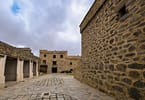Most people have never heard of the hirola. The fawn-colored antelope is a shy animal, with a long thin face and spectacled eyes. And yet this unassuming creature is the center of what may be one of the most successful conservation efforts in recent history, as well as the heroes – the equally unassuming Somali pastoralists who live alongside them on the East bank of the Tana River.
The Abdullah Somali community that run the Ishaqbini Conservancy in north-east Kenya have always had a fondness for the hirola, whose docile nature has earned it the nickname of ‘the stupid antelope’ in other communities. It is endemic to north-east Kenya and south-west Somalia, but populations have declined by over 80% since 1990. Numerous factors, including disease, hunting and loss of grasslands, have contributed to this.
Ishaqbini is part of a network of 33 community conservancies in northern Kenya, operating under the umbrella of the Northern Rangelands Trust (NRT). Together they are managing over 44,000 km² of land, stretching from the Indian Ocean to the Great Rift Valley. Not only are they conserving wildlife, but they are securing peace and building resilient livelihoods for rural communities on the back of it.
Sourcing the funding and support they needed through Northern Rangelands Trust, the Kenya Wildlife Service and others, the Ishaqbini community built a 3,000 hectare, predator-proof enclosure in an attempt to protect the last remaining hirola in their area. In August 2012, 48 hirola were herded up from surrounding areas and moved into the sanctuary. This was the first fenced sanctuary on community land in Kenya dedicated for the conservation of a critically endangered species.
The Ishaqbini Conservancy team raised awareness about the plight of the hirola amongst the local people, and dedicated conservancy rangers to anti-poaching patrols outside the sanctuary and full time monitoring of individual hirola herds in the sanctuary. Through NRT, they had access to expert scientific advice to help them shape their conservation and management strategies. But not even they could have predicted the impact these efforts would have.
In January 2016, an aerial and ground survey revealed just how much their hard work has paid off. An estimated 97 hirola were found within the Sanctuary, and several heavily pregnant females promise to bring this number into the hundreds very soon. From an initial population of just 48, hirola numbers have doubled in just three and a half years.
“The 50% increase in hirola numbers epitomises the opportunity and strength of the growing community conservation movement across Kenya,” says NRT’s Director of Conservation, Ian Craig. “The future of Kenya’s wildlife is inextricably linked with the development of the communities that live with wildlife. Kenya’s community conservancies are widely recognised across the world as one of the most innovative models in Africa empowering people to make informed decisions about management of their land whilst benefitting from wildlife and accessing new and alternative income.”
NRT member conservancies are managed by democratically elected boards and staffed by local people, often mixing ethnic groups that have historically fought with one another. Although the conservancies are still dependent on donor funds, they raise increasingly large sums from commercial activities related to conservation (through NRT Trading Ltd.), from County governments and from tourism. The profits are being channelled into education, health care and development activities.
The Northern Rangelands Trust, one of Kenya’s most respected conservation groups, is an umbrella organisation that has established several resilient community conservancies which have broadly transformed lives, secured peace, and conserved natural resources.
There are now 33 NRT-member community conservancies across northern and coastal Kenya, home to over 300,000 people who are managing over 42,000 square kilometres of land and safeguarding a wide range of species and habitats.
NRT is now widely seen as a text book example of how to support community conservancies.
WHAT TO TAKE AWAY FROM THIS ARTICLE:
- Sourcing the funding and support they needed through Northern Rangelands Trust, the Kenya Wildlife Service and others, the Ishaqbini community built a 3,000 hectare, predator-proof enclosure in an attempt to protect the last remaining hirola in their area.
- The Ishaqbini Conservancy team raised awareness about the plight of the hirola amongst the local people, and dedicated conservancy rangers to anti-poaching patrols outside the sanctuary and full time monitoring of individual hirola herds in the sanctuary.
- The Abdullah Somali community that run the Ishaqbini Conservancy in north-east Kenya have always had a fondness for the hirola, whose docile nature has earned it the nickname of ‘the stupid antelope' in other communities.






















